Training Tips: Using Collars and Harnesses Effectively for Behaviour Correction

Training Tips: Using Collars and Harnesses Effectively for Behaviour Correction
Training your dog is a rewarding journey that strengthens the bond between you and your furry friend. Essential to this process is choosing the right equipment, such as collars and harnesses, and using them effectively for behavior correction. In this guide, we'll explore practical tips to ensure that the training experience is positive for both you and your canine companion.
Positive Reinforcement
Associate the Gear with Positivity
Make wearing the collar or harness an enjoyable experience for your dog. Associate it with treats, praise, and playtime. This positive reinforcement helps create a positive association with the training gear, making your dog more receptive to wearing it.
Gradual Introduction
Take It Slow
For dogs new to wearing collars or harnesses, introduce the gear gradually. Allow your dog to sniff and investigate before putting it on. Start with short periods, gradually increasing the time as your dog becomes more comfortable.
Correct Fit
Measure for Success
A well-fitted collar or harness is essential for effective behavior correction. Measure your dog's neck for a collar and chest for a harness to ensure a snug but not tight fit. Check the fit regularly, especially for growing puppies.
Leash Etiquette
Proper Leash Usage
When using a collar or harness for behavior correction, it's crucial to maintain proper leash etiquette. Use gentle, controlled movements, avoiding sudden jerks that can cause discomfort. This helps your dog understand your cues without causing stress.
Consistency is Key
Reinforce Training Consistently
Consistency is the cornerstone of successful training. Use the collar or harness consistently during walks and training sessions. This repetition helps reinforce positive behavior and corrects unwanted habits over time.
Seek Professional Guidance
Consult with a Professional Trainer
If you're unsure about the best approach for behavior correction, consider seeking guidance from a professional dog trainer. They can provide personalized advice and demonstrate effective techniques tailored to your dog's specific needs.
Conclusion
Using collars and harnesses for behavior correction is a valuable aspect of dog training. By incorporating positive reinforcement, introducing the gear gradually, ensuring a correct fit, and maintaining consistency, you'll create a positive training experience for your furry friend. Remember, every dog is unique, so be patient and adapt your approach to suit their individual needs. Happy training!

